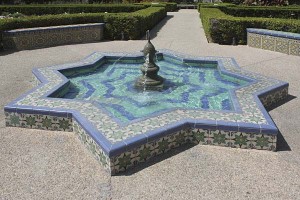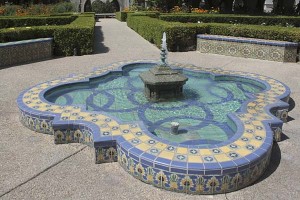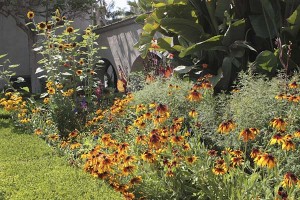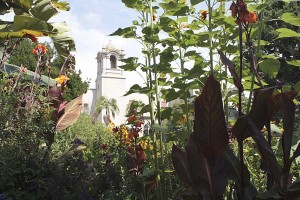My thanks to James Golden of View from Federal Twist for bringing to my attention a book that he thought would speak to this Californian’s attempts to garden in a land with little water. Penelope Hobhouse’s The Gardens of Persia traces the development of gardens in the rainfall-challenged area, beginning with the the earliest known garden for which we have an archaeological record, Cyrus the Great’s gardens at Pasargadae, which date to the 6th century, BCE.
That earliest garden featured a rectangular space divided symmetrically into smaller rectangles by two water courses that intersected at a 90 degree angle. It’s a basic formula that would develop through the centuries into the Islamic, Mughal and Moorish gardens which, in turn, went on to influence garden-making in Europe and beyond.
Cyrus’s garden used water in a way that treated it as a precious resource in a desert land but also showed off the fact that water was available to the owner of the garden, reinforcing the prestige and power of the ruler. Subsequent gardens in Persia continued to strike this balance. They used water in careful, strategic ways, treating it as the rare resource it was, often in narrow channels where evaporation would have been minized under the desert sun. At the same time they highlighted the power of the owner of the garden, and perhaps helped to conflate water’s life-giving powers with legitimacy of the ruler.
Here in San Diego, you can see an interpretation of a Persian-influenced Moorish garden in Balboa Park’s Alcazar Garden. Purportedly “patterned after the gardens of Alcazar Castle in Seville, Spain,” the garden is a 1935 design by local architect Richard Requa, built for the 1935-36 California Pacific International Exposition.
Although I’ve never been to the Alcázar in Seville, a quick trip to the satellite overview of the original Alcázar gardens on Google Maps reveals the California garden to be a fairly loose interpretation of what you’ll find in Spain. But it retains strong overtones of traditional Persian gardens in its strong symmetry and thrifty use of water. (Garden sightseeing via Google Maps works really well for overviews of large gardens with strong structure. Take a look at Versailles or Isola Bella.)
In the Balboa Park garden each of the intersections of the main central axis and two perpendicular axes is celebrated by a small tiled fountain, six to eight feet across. Neither fountain throws water more than a few inches away from the fountainhead.
With San Diego’s current water restrictions, homeowners can’t have any sort of fountain that shoots water into the air. So even fountains that are as measured in their use of water as these are wouldn’t be permitted. But evaporation and water waste on this style of fountain is so different from what you’d have with civic fountains that are more like unplugged fire hydrants. (Think of the fountains in Las Vegas at Bellagio.) These little Moorish fountains celebrate water, they don’t waste it.
The garden features borders of clipped boxwood that outline the rectangles of the garden beds. Seasonal plantings rotate in an out of these bordered areas. Lavender, cosmos, and Shasta daisies were filling in the central rectangles on this July afternoon, with rudbeckia, penstemon, iresene, cannas, sunflowers and other warm-weather plants on the margins.
Are these plantings historically accurate? With the exception of the lavender, not at all. But chances are that if the Persian rulers were around today, they would used whatever materials were available to them, especially if they were plants that spoke to power and conquest over distant lands. Plants from all over the globe and modern hybrids would only serve to reinforce the viewer’s sense of the ruler’s power.
Penelope Hobhouse makes a similar observation about choice of plant materials in the Persian-influenced gardens at the Generalife in Grenada: “Archaeologists discovered that the garden must originally have been planted with low-growing flowers requiring little soil, although there were some deeper pits obviously made for shrubs, such as myrtle, and orange trees which had been described as growing there in the 16th century. After the excavations the soil was returned to the Acequia Court, and today modern annuals with no historical authenticity give a colorful display.”
If you were wanting to make a historically-correct Persian garden Hobhouse’s text list many other options throughout, including various roses, tulips, and several trees including white poplar, plane trees, plums, apricots, and apples.
Another resource for historical plants would be Ali Akbar Husain’s Scent in the Islamic Garden: A Study of Deccani Urdu Literary Sources, a study that I knew nothing about until I happened to see it sitting on the shelf next to the Hobhouse book in the library. This fairly academic but quite readable book concentrates on Mhugal gardens and provides a long appendix of specifically fragrant plants mentioned in garden texts. Although the focus is on texts from India, plants of of European origin make up a big part of the list.
Many of the selections don’t come as any surprise: several rose species, narcissus, violets, lavender, jasmine, mint, crinum, crocus, lilies, iris. But a couple would be surprising selections for gardens today: one of the stinking corpse flower species (Amorphophallus camanulatus) and cannabis (yes, that cannabis).






Very interesting – formal gardens are so not in the mainstream of native plant gardens. Glenn Keator in _Complete Garden Guide to the Native Perennials of California_ says quite dogmatically: “[T]he essence of successful native plant design — to create a landscape without contrived design. … [R]emember to make repetitions look random. … Nothing is worse than to space all plants in geometric designs” (p 24-25).
But I also think of gardens as historically guarded places apart, as specifically not random and wild — a respite from the wildness, not a recreation of it. The symbolism of the garden in medieval Christianity and art, Mary and the rose, formalism and symbolism – all very interesting topics. Thanks for sending my thoughts spinning off in this direction.
Thanks for those links to Versaille and Isola. Those are really neat from the air. Interesting info for sure. When I was in Iraq I so wanted to see the Hanging Gardens of Babylon, but was not lucky enough. Some of the gardens in that region are awesome and I find them very interesting. So now I need to look for that book!
CM, I find it interesting that these days a lot of gardens are seen as respite not from the wilderness but from the confines of social life. I have no doubt that at least of the motivation for naturalistic planting has its roots in that reversal of how we regard the land beyond the city’s edge. I’m definitely more drawn to that style of garden-making, but I do find comments like the one you quote from Glenn Keator’s book to be, as you point out, pretty dogmatic. I think that one of the best thing people can do for native plants is to show that they can be incorporated into most gardening styles, not just nature-inspired ones. In the Balboa Park garden I showed, just imagine hedges of clipped berberis or rhamnus, interplanted with rotating displays of boisterous winter and spring annuals, tall summer Hooker’s primroses, autumn epilobiums… I won’t be the first to mention that the invertebrates don’t care if you have a faux natural garden, a cottage garden or a Medieval recreation of earthly paradise.
Tina, the location of the original hanging gardens appears to be subject to a bit of debate, and that anything you could see today would be something “Saddam Hussein attempted to reconstruct using modern brick,” according to the Hobhouse book. Historical or not, it still would have been a sight to see.
Fascinating overall.
And I was unfamiliar with ‘Scent in the Islamic Garden.’ A book to look for, certainly.
I hope we can meet up when I finally get to San Diego one day! Alice
Alice, drop me a note if ever you’re headed this way! This second book is definite a focused, non-generalist’s sort of garden book, but one with a great sense of history and place.
James, my image of the Alcazar was that it was very shaded. Wonderfully shady in fact. That doesn’t seem to be the case with the garden you describe. But I can’t remember where the shade came from. The same with the Alhambra gardens. I think it was from buildings rather than vegetation.
visited the Alcazar on the Spanish sojourn, and there is tons of welcome shade from huge, really huge, mature trees…ficus, palms, oranges (well, of course, it’s Seville), and conifers among them. Where the Alhambra really won out in Persian garden style was the h2o -many of the Alcazar’s fountains were dry- and scented plantings. Many of the parterres at the Alcazar were bare earth…there were, however, wonderful peacocks, parrots, and baby ducklings in place of flowers. It was in a book on the scented gardens of Persia that I first discovered muscari macrocarpum, the banana-scented grape hyacinth…love. Also, if you are visiting Seville, I recommend picnicking in the Parque Maria Luisa. My sister fell asleep there every time we went!
Jo, looking at the satellite map of the Alcazar, it’s pretty clear that the geometrical garden is planted with a number of large trees–including date palms–in a pattern that seems to buck the geometry of the garden. I’m sure some of the shade came from the trees.
Out of Doors, thanks for the personal reports of these two gardens. I can imagine the big trees being a big relief from the sun on the hottest summer days, and the fact that they fruited is a great bonus. One of the neighborhoods in town during the 80s had an escaped peacock that made its rounds through people’s gardens. They can be noisy as all get out, but the males are pretty spectacular. My garden is fairly planted out, but I’m sure I can make room for a tiny little muscari that smells of bananas! (And I just checked: Seville airfare less than $800. Tempting.)
I remember falling asleep in the Maria Luisa gardens really well 🙂
There was a brightly tiled McGredy Rose garden in that park if I remember rightly, which seemed incongruous somehow.
And the deep shade: I skulked in the lea of the main wall. Always make a bee-line for dark corners. Do bees do that? Probably not.
James: Thanks for the trip down memory lane.
and we too have escaped peacocks ( brought in with the yearly 750 pheasant chicks for the shoot). Seeing an unexpected ghostly white one wandering about gives one a real shock.